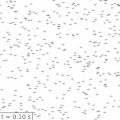Archivo:Lamb–Oseen vortex animation.gif
Lamb–Oseen_vortex_animation.gif (400 × 400 píxeles; tamaño de archivo: 3,46 MB; tipo MIME: image/gif, bucleado, 250 frames, 27s)
|
|
Este es un archivo de Wikimedia Commons, un depósito de contenido libre hospedado por la Fundación Wikimedia. Más abajo se reproduce su página de descripción con la información sobre su origen y licencia. |
Resumen
| DescripciónLamb–Oseen vortex animation.gif |
English: Animation of the Lamb–Oseen vortex equation in air, aging up to 25 seconds.
Viewed window size is 20 cm in width (out of an infinite air space). Floating particles show the movement of the fluid as well as local vorticity; the growing boundary between the rotational vortex core and the irrotational exterior can be clearly seen. Viscosity = 1.5e-5 m^2/s (air under standard conditions), Circulation = 1e-2 m^2/s. See also File:Rankine_vortex_animation.gif for the same done with a Rankine vortex. |
| Fecha | |
| Fuente | Trabajo propio |
| Autor | Nanite |
Source
Python source code. Requires matplotlib ImageMagick. Possibly does not run in Windows.
#!/usr/bin/env python3
import numpy as np
from scipy.special import expi
from matplotlib import pyplot as plt
from matplotlib import collections
twopi = 2*np.pi
# kinematic viscosity m^2/s
viscosity = 1.5e-5
# fixed circulation of the lamb-onseen vortex, m^2/s
circulation = 10e-3
# radial range in which to place particles, m
rmax = 0.2
rmark = 0.003 # radius of 'marker'
# number of particles
N = 600
# radial coordinate of particles, this does not change over time
# place them with sqrt of uniform 1D-distributed so they are uniform in 2D
part_r = rmax * np.sqrt(np.linspace(0, 1, N+1)[1:])
# precalculate some things
invr2 = 1/part_r**2
neg_tprime = -part_r**2 / (4 * viscosity) # negative of transition time for this radius
# angular coordinate of particles, set them randomly.
part_th = twopi*np.random.rand(N)
# rotation of particles - start them all out as horizontal
part_rot = np.zeros((N,))
dt = 0.01
i = 0
frames = []
frametimes = []
nextframetime = 0
fig = plt.figure()
fig.set_size_inches(4,4)
ax = plt.axes((0,0,1,1))
ax.set_xlim(-0.7*rmax, +0.7*rmax)
ax.set_ylim(-0.7*rmax, +0.7*rmax)
ax.set_aspect('equal')
ax.set_axis_off()
linesegs = np.empty((2*N, 2, 2))
while True:
i += 1
t = i*dt
if t > 25:
break
# use finite difference to increment angular coordinate and rotation of particles.
# we oould calculate these in closed form in terms of Ei(x) function, but this
# is easy and good enough.
part_th += (-dt * circulation / twopi) * np.expm1(neg_tprime/t) * invr2
# note the rotation of particle is half of the vorticity.
part_rot += (dt * circulation / (4*twopi*viscosity * t)) * np.exp(neg_tprime/t)
# only show every tenth frame
if i % 10 == 0:
frame = f"frames/frame{i}.png"
frames.append(frame)
frametimes.append(t)
[c.remove() for c in ax.lines]
[c.remove() for c in ax.collections]
[c.remove() for c in ax.texts]
x = part_r*np.cos(part_th)
y = part_r*np.sin(part_th)
cr = rmark*np.cos(part_rot)
sr = rmark*np.sin(part_rot)
# first line segments of the crosses
linesegs[0::2, 0, 0] = x + cr
linesegs[0::2, 0, 1] = y + sr
linesegs[0::2, 1, 0] = x - cr
linesegs[0::2, 1, 1] = y - sr
# second line segments of the crosses - perpendicular
# note that having them distinct length or shade makes it visually MUCH easier to see
# distinction between the rotational core and irrotational exterior, due to distinct texture.
linesegs[1::2, 0, 0] = x - sr
linesegs[1::2, 0, 1] = y + cr
linesegs[1::2, 1, 0] = x + sr
linesegs[1::2, 1, 1] = y - cr
linecoll = collections.LineCollection(linesegs, linewidths=1, colors=((0., 0., 0.), (0.75, 0.75, 0.75)),
linestyle='solid')
ax.add_collection(linecoll)
[c.remove() for c in fig.texts]
fig.text(0.01,0.01,f't = {t:.02f} s', fontsize='x-large', bbox=dict(facecolor='w', alpha=1))
fig.savefig(frame)
# gif frame times are in centiseconds
delays = list(np.diff(np.round(np.array(frametimes) * 100)))
# show the last frame for a bit extra time
delays.append(delays[-1] + 200)
print(len(frames), len(delays))
assert(len(delays) == len(frames))
### Assemble animation using ImageMagick ###
calllist = 'convert'.split()
for delay,frame in zip(delays,frames):
calllist += ['-delay',str(int(delay))]
calllist += [frame]
calllist += '-loop 0 -layers Optimize _animation.gif'.split()
f = open('anim_command.txt','w')
f.write(' '.join(calllist)+'\n')
f.close()
print("composing into animated gif...", end='')
import sys, subprocess, os
sys.stdout.flush()
subprocess.call(calllist)
print(" done")
os.rename('_animation.gif','animation.gif')
Licencia
| Este archivo está disponible bajo la licencia Creative Commons Dedicación de Dominio Público CC0 1.0 Universal. | |
| La persona que ha asociado una obra a este documento lo dedica al dominio público mediante la cesión mundial de sus derechos bajo la ley de derechos de autor y todos los derechos legales adyacentes propios de dicha, en el ámbito permitido por ley. Puedes copiar, modificar, distribuir y reproducir el trabajo, incluso con objetivos comerciales, sin pedir aprobación del autor.
http://creativecommons.org/publicdomain/zero/1.0/deed.enCC0Creative Commons Zero, Public Domain Dedicationfalsefalse |
Leyendas
Elementos representados en este archivo
representa a
Algún valor sin elemento de Wikidata
8 jun 2020
Historial del archivo
Haz clic sobre una fecha y hora para ver el archivo tal como apareció en ese momento.
| Fecha y hora | Miniatura | Dimensiones | Usuario | Comentario | |
|---|---|---|---|---|---|
| actual | 13:43 8 jun 2020 |  | 400 × 400 (3,46 MB) | Nanite | Uploaded own work with UploadWizard |
Usos del archivo
La siguiente página usa este archivo:
Uso global del archivo
Las wikis siguientes utilizan este archivo:
- Uso en en.wikipedia.org

